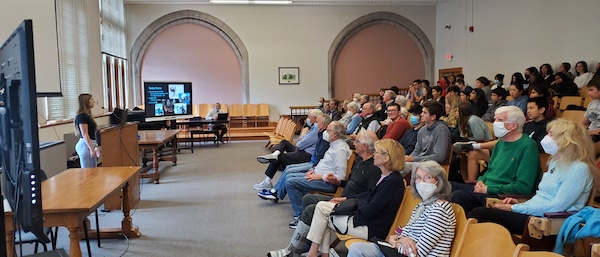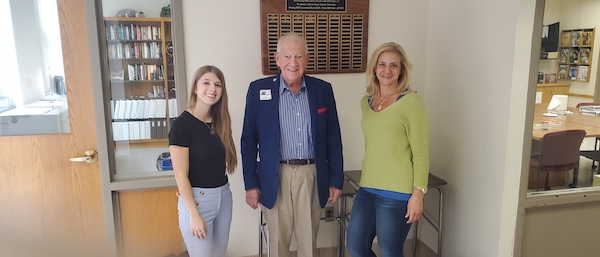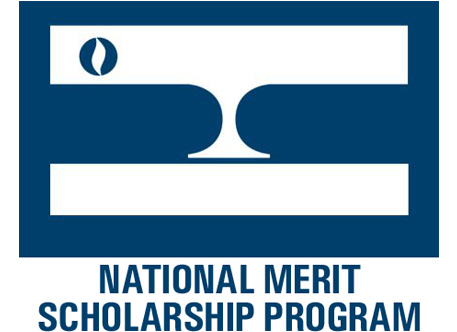SHS Class of 1961 Celebrates Reunion with a Galaxy Forum
- Details
- Written by: Elisa Perednia
- Hits: 2297
 Scarsdale local history and future visions were in focus at Scarsdale High School (SHS) at the 60th- 61st class reunion weekend for SHS alumni class of 1961. Held in-person from September 30 - October 2, the event was inaugurated by ILOA Galaxy Forum SHS 2022 and followed by a discussion lead by SHS Principal Ken Bonamo, and a tour of SHS facilities.
Scarsdale local history and future visions were in focus at Scarsdale High School (SHS) at the 60th- 61st class reunion weekend for SHS alumni class of 1961. Held in-person from September 30 - October 2, the event was inaugurated by ILOA Galaxy Forum SHS 2022 and followed by a discussion lead by SHS Principal Ken Bonamo, and a tour of SHS facilities.
Opening the class reunion on September 30 was ILOA Galaxy Forum SHS 2022, the 10th such Galaxy Forum at Scarsdale High School. Galaxy Forum 2022 highlighted the SHS Centennial Plaque which was dedicated to the school in 2017 and hangs outside the Science Department. It was presented to Science Department Chair Nicole Pisano and the SHS Science Department for advancing 21st Century science education and for hosting the Galaxy Forums since 2011.
The plaque honors the first 100 years since the schools’ founding (1917-2017), and the SHS Galaxy Forum program future Centennial, projected to be held annually at the school (2011-2111), with metal nameplates set for engraving through 2111 and beyond. It acts as a living time capsule, being added to each year symbolizing long-range commitment and future visions of science / space education excellence.

The annual SHS Galaxy Forum program is sponsored by SHS Class of 1961 Alum Steve Durst, founder of Hawai’i-based International Lunar Observatory Association (ILOA).
This year Durst spoke during the SHS Galaxy Forum about Milky Way Galaxy 21st Century Education and the ILOA precursor astronomy instruments set to land on the moon in the Spring of 2023 aboard Intuitive Machines IM-1 mission via SpaceX Falcon 9 rocket. The payload will aim to capture the first ever pictures of the Milky Way galaxy from the surface of the moon with Aloha.
Bailey Burns, a Systems Engineer at Paragon Space Development Corporation, was the featured presenter for SHS Galaxy Forum 2022 and discussed her work and company efforts to advance the Artemis Generation (the next-generation of lunar explorers after Apollo missions), the emerging Cislunar Space Age, and the return to the Moon – for good!
Inspiring the students at SHS to aim for the stars, could the Galaxy Forum program and Centennial Plaque help distinguish SHS and enable Scarsdale on the moon in this century?
 Bailey Burns, Steve Durst and Nicole Pisano
Bailey Burns, Steve Durst and Nicole Pisano
Scarsdale Football Team Triumphs 27-21 Over Arlington
- Details
- Written by: Ethan Fader
- Hits: 1767
 The Scarsdale Varsity Football Team beat formerly ranked team Arlington in a thrilling upset on Friday night. Senior and captain Colby Baldwin (pictured above) scored the winning touchdown, leading the Raiders to victory, 27-21.
The Scarsdale Varsity Football Team beat formerly ranked team Arlington in a thrilling upset on Friday night. Senior and captain Colby Baldwin (pictured above) scored the winning touchdown, leading the Raiders to victory, 27-21.

The SHS Raiders charged against Arlington's powerful defense during their first home game of the season on Friday night Setpember 23, 2022.
The team is now 3-0.
Board of Ed Asks for Your Participation in Superintendent Search Process
- Details
- Written by: Joanne Wallenstein
- Hits: 1447
 (Here's a reminder from the Scarsdale Board of Education)
(Here's a reminder from the Scarsdale Board of Education)
Dear Scarsdale Community,
This is a reminder that the Superintendent Search Survey closes in 2 days, on September 23, 2022 at 5 p.m. If you haven’t already, please follow this SURVEY LINK to provide your input.
The final Community Forum is tomorrow, Thursday, September 22, 2022, at 7:00 p.m. (via Zoomlink).
Whether you complete the survey, attend a focus group, or do both, the Board urges you to take the opportunity to provide your input. Your participation is essential for a successful Superintendent search!
For additional details, please see our September 8th communication regarding community engagement or visit our superintendent search page.
Thank you for your input in finding an exceptional Superintendent to lead the Scarsdale Schools!
Sincerely,
The Board of Education
National Merit Semifinalists Named
- Details
- Written by: Joanne Wallenstein
- Hits: 6294
 Twelve students from Edgemont High School and twenty eight students from Scarsdale High School are among the 16,000 named as semifinalists in the 68th annual National Merit Scholarship Program. These high school seniors have an opportunity to continue in the competition for some 7,250 National Merit Scholarships worth nearly $28 million that will be offered next spring. To be considered for a Merit Scholarship® award, Semifinalists must fulfill several requirements to advance to the Finalist level of the competition. About 95 percent of the Semifinalists are expected to attain Finalist standing, and approximately half of the Finalists will win a National Merit Scholarship, earning the Merit Scholar® title.
Twelve students from Edgemont High School and twenty eight students from Scarsdale High School are among the 16,000 named as semifinalists in the 68th annual National Merit Scholarship Program. These high school seniors have an opportunity to continue in the competition for some 7,250 National Merit Scholarships worth nearly $28 million that will be offered next spring. To be considered for a Merit Scholarship® award, Semifinalists must fulfill several requirements to advance to the Finalist level of the competition. About 95 percent of the Semifinalists are expected to attain Finalist standing, and approximately half of the Finalists will win a National Merit Scholarship, earning the Merit Scholar® title.
The names are as follows:
Edgemont High School
Samika Agarwal
Justin P. Alexander
Skandan Gurumurthy
Julia Hu
Aarya J. Kumar
Chaemin Lim
David I. Litvack
Rajan S. Sandhu
Raj Savla
Andrew D. Shane
Vivien F. Wong
Maxwell F. Yang
Scarsdale High School
Matthew Barotz
Claire Chou
Cindy Y. Dedianous
David Diao
Thomas D. Dilorenzo
Ali El Moselhy
Jackson Fielding
Isabella Frank
Carly S. Gelles
Oliver S. Hong
Anushka Kumar
Mason Y. Lau
Hyunjin Lee
Amelia Liu
Olivia Liu
Emily-Jane Luo
Michael Marks
Colin H. Michael
Amanda D. Nudelman
Bryan Shi
Katherine Shi
Noa S. Shiloach
Steven C. Su
Emily Q. Wang
Hannah Y. Wang
Benjamin P. Yacoub
Maxwell Zhang
Matthew Zhao
Steps in the 2023 Competition
High school juniors entered the 2023 National Merit Scholarship Program by taking the 2021 Preliminary SAT/National Merit Scholarship Qualifying Test (PSAT/NMSQT®), which served as an initial screen of program entrants. The nationwide pool of Semifinalists, representing less than one percent of U.S. high school seniors, includes the highest-scoring entrants in each state. The number of Semifinalists in a state is proportional to the state’s percentage of the national total of graduating seniors.
To become a Finalist, the Semifinalist and a high school official must submit a detailed scholarship application, in which they provide information about the Semifinalist’s academic record, participation in school and community activities, demonstrated leadership abilities, employment, and honors and awards received. A Semifinalist must have an outstanding academic record throughout high school, be endorsed and recommended by a high school official, write an essay, and earn SAT® or ACT® scores that confirm the student’s earlier performance on the qualifying test.
From over 16,000 Semifinalists, more than 15,000 are expected to advance to the Finalist level, and in February they will be notified of this designation. All National Merit Scholarship winners will be selected from this group of Finalists. Merit Scholar designees are selected on the basis of their skills, accomplishments, and potential for success in rigorous college studies, without regard to gender, race, ethnic origin, or religious preference.
National Merit Scholarships
Three types of National Merit Scholarships will be offered in the spring of 2023. Every Finalist will compete for one of 2,500 National Merit® $2500 Scholarships that will be awarded
on a state-representational basis. About 950 corporate-sponsored Merit Scholarship awards will be provided by approximately 180 corporations and business organizations for Finalists who meet their specified criteria, such as children of the grantor’s employees or residents of communities where sponsor plants or offices are located. In addition, about 160 colleges and universities are expected to finance some 3,800 college-sponsored Merit Scholarship awards for Finalists who will attend the sponsor institution.
Give Your Input on the Search for a New Schools Superintendent
- Details
- Written by: Joanne Wallenstein
- Hits: 1597
 The following letter was sent to us by Amber Yusuf and Ron Schulhof, President and Vice President of the Scarsdale School Board:
The following letter was sent to us by Amber Yusuf and Ron Schulhof, President and Vice President of the Scarsdale School Board:
Dear Scarsdale Community,
The search for the next Superintendent of Schools is underway and we hope you will take the opportunity to provide your input! We are committed to conducting an inclusive, thoughtful and comprehensive process. The Board of Education has planned for extensive community engagement, including focus groups, community forums, and a survey.
The Board welcomes your input as feedback from the school community will be used to develop a set of search specifications to create a Leadership Profile. This Leadership Profile will serve as a guiding framework for recruiting and vetting candidates.
The survey is conducted by a search firm, which ensures that your individual responses are kept anonymous. The survey is available in English, Spanish, Mandarin and Portuguese.
The survey is available online here and will remain open until September 23rd at 5 p.m.
We also invite you to attend any of the three community forums, on the following dates:
● Wednesday, September 14, 2022, at 9:30 a.m. (Scarsdale Public Library, Scott Room)
● Monday, September 19, 2022, at 7:00 p.m. (Scarsdale High School, Room 170-172)
● Thursday, September 22, 2022, at 7:00 p.m. (via Zoom.)
Whether you attend a community forum, complete the survey, or do both, the Board hopes you will take the opportunity to provide your input! Learn more here.
With thanks,
Amber Yusuf, Board of Education President
Ron Schulhof, Board of Education Vice President










